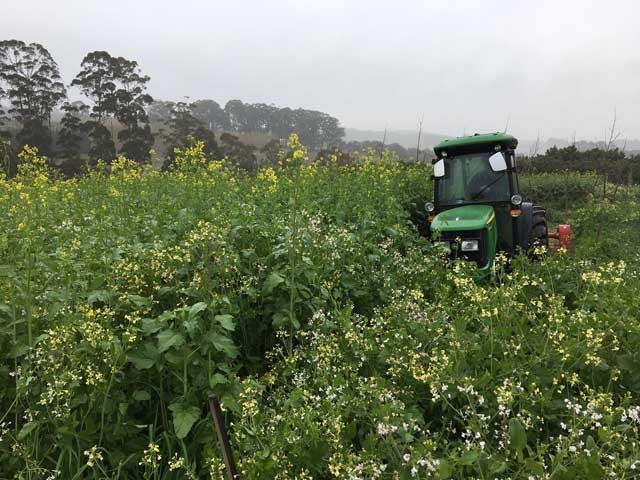Old apple ground can harbour apple replant disease (ARD) which reduces new tree growth and production by about 20% a year for each year of the tree’s life.
In 2017 a trial was set up by the apple industry (a Future Orchards® trial) to assess options for managing apple replant disease by observing the growth rate of a new planting of Fuji apples on MM106 rootstock into old apple ground under five different pre-plant treatments.
The treatments consisted of two biofumigation mixes, beneficial bacteria, chloropicrin, and the standard practice of metham sodium fumigation.
The trial was conducted in an orchard at Manjimup in Western Australia and is now in the third leaf.
Two treatments stand out at the end of the third season and trees planted with these treatments have performed exceptionally well. They are:
• Treating the soil with the chemical fumigant chloropicrin. Although a well-known ARD treatment elsewhere, chloropicrin treatment has not been a standard practice in the south-west of WA due to the expense of hiring certified contractors from outside the area to apply the fumigant.
• The relatively new approach of application of beneficial bacteria onto the root system during planting to improve soil health.
Treatments
The demonstration site tested:
• biofumigant seed mixes of mustard and rocket
• mustard and Ethiopian cabbage
• a beneficial bacteria product (Serenade® Prime)
• the chemical fumigant chloropicrin (Rural Telone C-60 applied by an accredited contractor)
• the standard grower practice treatment of metham sodium.
A block of Fuji was planted on 12 October 2017 onto ground that in the previous years had grown Fuji apples at 5m row spacing and 3m tree spacing on MM105 rootstock.
The new planting was planted at 3.5m x 0.8m spacing on MM106 rootstock under sprinkler irrigation.
Each treatment strip is 20m wide across the block and five trees in the centre rows of each treatment have been monitored throughout the project.
Biofumigation
Biofumigation is the practice of using specialised plants from the Brassicaceae and Sorghum families that naturally produce chemicals that suppress soil-borne pathogens and break the life cycle of pests and diseases.
The brassica crop is mulched at early flowering stage. The maceration process breaks down sulphur-containing glucosinolates in the plant to release isothiocyanates that are toxic to soil-borne pests and pathogens.
Biofumigation has been shown to have some control of soil-borne pathogens including Sclerotinia, Rhizoctonia, Alternaria, Colletotrichum, Fusarium, Phytophthora, Pythium, Verticillium wilt, as well as root-knot nematode.
The demonstration trial tested two different biofumigation seed mixes.
Mix 1 consisted of 90% mustard and 10% rocket planted at 20 kg/ha. Mix 2 consisted of 75% Ethiopian cabbage and 25% mustard planted at 10 kg/ha. Both were planted on 22 May 2017.
Both mustard mixes were seeded and grown until they reached flowering. They were then cut, mulched and ploughed in and left for three weeks so that the biofumigation activity could occur and the plant material could break down.
The site received over 100 mm of rainfall in this time which assisted breaking down plant material and helping release the biofumigant gas.
Beneficial Bacteria
Serenade® Prime was applied via a soil drench to each tree at a rate of 35 mL per tree at the time of planting.
(cont next issue)
See this article in Tree Fruit Nov 2020
Reproduced with permission and thanks to APAL and Australian Fruit Grower




















